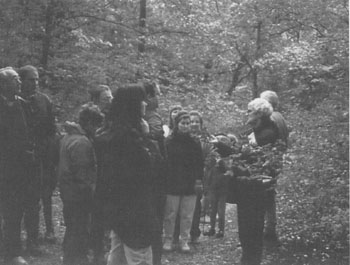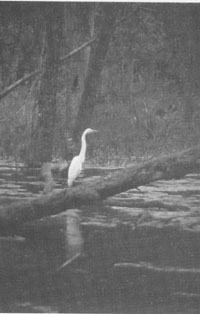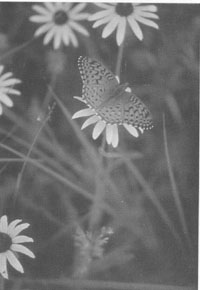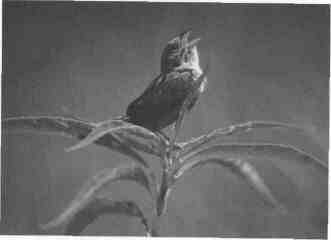SPECIAL FOCUS
Chicago Wilderness
Urban dwellers in Chicagoland find beauty and biodiversity
in these protected woodlands, prairies and wetlands
BY SANDI STEIN
© The Nature Conservancy.
Opportunities to explore the
Chicago Wilderness abound.
Hikers enjoy the Poplar Creek
Forest Preserve in Cook County.

|
While beauty is in the eye of the beholder, few will
disagree about what makes urban spaces beautiful:
lush and inviting open space offering a peaceful respite
from the stresses of city life.
But when one looks closer, the beholder might see
the individual elements that together create that
beauty. For example, native flowers and trees attract a
greater variety of butterflies, birds and other wildlife
that make our open spaces come alive. A natural
ecosystem—a wetland, say—is more beautiful when
it's healthy, thanks to the delicate balance of plants,
animals and microorganisms that keep it that way. |
This is the web of life called biological diversity or
"biodiversity." And this is the beauty seen by hundreds of conservationists who have joined together in
the Chicago Region Biodiversity Council, or Chicago
Wilderness.
The Council is a collaboration of 92 public
agencies and private organizations dedicated to the
protection, restoration, and stewardship of the natural
communities of the Chicago region through fostering
their compatibility with the human communities
whose lives they enrich.
Chicago Wilderness is also the Council's name to
designate the lands and natural resources stretching
from southeast Wisconsin, through northeastern
Illinois, to northwest Indiana, that include 200,000
acres of local, state, federal and private conservation
lands.
Chicago Wilderness seems to be an oxymoron, but
this region harbors some of the finest surviving
examples of eastern tallgrass prairie and open oak
woodlands or savannas, which support nearly 200
species listed as endangered or threatened in Illinois.
Since less that one-tenth of one percent of Illinois'
tallgrass prairie and even smaller fragments of oak
savanna remain, these grassland and woodland
communities are more rare than the tropical rain
forests.
Financial support for Chicago Wilderness is
provided by the member organizations, as well as
through additional private and local, state and federal
grants. Member organizations work together to
develop and submit projects in the areas of land
management, science, education and communications. Before receiving Council funding, each project must address a critical conservation need, based upon
26 / Illinois Parks and Recreation
CHICAGO WILDERNESS
the key recommendations of the new Chicago
Wilderness Biodiversity Recovery Plan. Since its
launch in April 1996, Chicago Wilderness has
funded 140 collaborative projects.
Following is a small sampling of Chicago Wilderness projects, which illustrate the value of collaboration and the dedication of hundreds of scientists,
educators and land managers to the preservation of
biodiversity. Together, they are healing our natural
communities for a healthier environment, for the
beauty of nature, and for future generations.
Backyard Biodiversity
To better connect Chicago-area residents to the
biodiversity value of the region, Openlands Project
(OLP) designed an education program called "Backyard Biodiversity," which focuses on area public parks and community and school gardens. The project's principal investigator is OLP's director of urban greening, Glenda Daniel. Collaborating partners are the City of
Chicago, Department of Environment; The Nature
Conservancy; Chicago Audubon Society; and The Field
Museum.
Three community garden workshops and six field
trips on garden design, preparation, planting, and seed
collection exposed residents to the diversity of species
around them. A demonstration garden was planted in
Chicago's North Lawndale neighborhood, and handson biodiversity education and schoolyard garden
projects were held at the John Hay Community Academy in Austin and the ABC Youth Center in North<
Lawndale. Openlands Project produced brochures on
the biodiversity value of community gardens and the
¦ Chicago Audubon Society added information to their
brochures on plants that attract birds and butterflies
and how to build birdhouses and feeders.
The project demonstrates that using open space in
the city to support native plant and animal habitats
can result in an increase in biodiversity. But even
more important, heightening public awareness of
nature leads to more active participation in conservation and restoration efforts.
Restoration and Interpretation of
The Grove National Historic Landmark
One of Chicago Wilderness' major demonstration
projects is the Glenview Park District's The Grove
National Historic Landmark. The goal of this
project is to restore 110 acres of oak woodlands,
prairie and savanna ecosystems and to develop a
protocol with the Illinois Department of Natural
Resources for restoration of herpetofauna. The
principal investigator is Stephan Swanson, director
of The Grove. Collaborators include the Chicago Botanic Garden, St. Charles
Park District and the U.S. Fish
& Wildlife Service.
A unique aspect of The Grove
is its available detailed natural
history records, which date back
to 1836. Early records show that
the landscape was open grasslands with groves of huge oak
trees. The existence of such presetdement information is
immensely valuable for biodiversity restoration.
Woodlands, prairies and
wetlands are being restored at
the site and dense non-native
plants like European buckthorn
and garlic mustard removed.
Controlled burns will be
reintroduced to prepare the soil
for seeding with native plants.
Non-indigenous trees that
inhibit growth of centuries-old
groves and that prevent sunlight
from reaching the forest floor are
being removed.
In addition to the historic,
biological and aesthetic goals of
returning The Grove to its
unspoiled splendor, the restoration work will result in
number of potential benefits to
the surrounding environment:
improved water quality, flood
control, native plant and wildlife
habitat enhancement, education
opportunities and improved
recreation opportunities. School
groups and the public will be
reached through on-site
initiatives, self-guided trail
brochures and three site-specific curricula for each of
the savanna, prairie and woodland ecosystems.

|

|
Photo at Left:
© The Grove National Historic
Landmark. Great egret at the
Glenview Park District's The
Grove, where a major restoration
project is underway, funded by
Chicago VWfefefness.
Right:
© Ron Panzer. An aphrodite
military visits a black-eyed suson
in the Chicago Wilderness.
Restoration ot the native
landscape attracts a greater
variety of wildlife and increases
biodiversity.
|
12 Natural Wonders
of the Chicago Wilderness
A communications campaign by Chicago Wilderness in 1998-1999 sought to increase public awareness and appreciation for the beautiful urban wilderness. "12 Natural Wonders of the Chicago Wilderness" was an integrated communications campaign
centered around the designation of 12 spectacular yet
accessible preserves throughout the region. The
program was led by Chicago Wilderness and involved
many member organizations, including: the
September/October 1999/ 27
CHICAGO WILDERNESS
Brookfield Zoo; City of Chicago, Department of
Environment; forest preserve districts of Cook,
DuPage, Kane and Will counties; Illinois Department of Natural Resources; Lake County Forest
Preserves; McHenry County Conservation District;
The Nature Conservancy; USDA Forest Service and
the USDI National Park Service.
The elements of the campaign included both
broad-based and targeted communications to raise
public awareness and provide a direct connection to
nature. At the core was the nature walks program, a
yearlong series of 29 guided walks. Led by skilled
interpreters from the collaborating partners, the
walks involved more than 500 people over the
course of the campaign. Other elements included
media coverage and materials produced for the
campaign such as the Natural Wonders guide,
poster and 1999 calendar. Another element was a
Media Workshop held in December 1998, introducing journalists to a multitude of biodiversity issues.
The final element of the campaign was direct
outreach to 15 community groups surrounding the
12 preserves, which included slide presentations
and personalized walks.
Restoration of Ferson / Otter Creek
Another demonstration project for Chicago
wilderness is being led by the St. Charles Park
District, with Mary Ochsenschlager as the principal investigator. Collaborating partners in "Restoration
of Ferson/Otter Creek" are the Forest Preserve
District of Kane County, Kane County Development Department, Kane County Stormwater
Committee, Illinois Department of Natural
Resources, USDA Natural Resources Conservation
Service, American Farmland Trust, Whearon
College, U.S. EPA, U.S. Fish & Wildlife Service
and the U.S. Army Corps of Engineers, Chicago
District.
The goal of the project is to identify restoration
techniques that have the greatest potential for
improving Ferson/Otter Creek and to restore a two mile, publicly owned stretch of the stream channel.
Investigators are using a geomorphological approach
to studying the creek's stability and behavior, which
will help predict future stream conditions. Data are
being gathered on sediment transport, discharge,
bank erosion, bed mobilization and channel
migration, and mapping is identifying tile outlets
and locating debris accumulation, levees and other
factors.
It is hoped that the project will serve as an
ecologically sensitive model for stream and watershed study and management. The results will guide
landowners in implementing restoration efforts.

|
Right:
© Chicago Wilderness. Although
the once-abundant Hensiow's
sparrow is a state-threatened
species, it is found in five of the six
counties of northeastern Illinois.
Restoration of large grassland
habitats is essential to its survival.
On page 28:
© Joseph Kayne. Diversity is the
sign of a healthy woodland,
bursting with spring wildflowers
such as Virginia bluebells and
blue-eyed Marys.
|
Ecological Investigation of Invertebrate
Populations of Spring Bluff, Elm Road
Forest, and Grainger Woods
Forest Preserves
Jim Anderson, a Lake County Forest Preserves
natural resources manager, is leading this study to
assess invertebrate populations found in temporary
ponds in oak woodlands and black oak savannas.
Collaborators include the Wisconsin and Illinois
chapters of The Nature Conservancy and the Illinois
Department of Natural Resources.
This project will inventory invertebrate species
found within the communities and conduct a quality
assessment using current biological indices. With the
inventory, investigators will identify species to serve
as quality indicators of the natural community.
Degraded and managed samples will help determine
the effects of restoration and other management
techniques on the area. Results from the study will be
compared to data that has been collected at Illinois
Beach State Park, Chiwaukee Prairie in southeastern
Wisconsin, among other sites.
The results of this and many other Chicago
Wilderness studies are intended to provide valuable
information for land management agencies looking to
more effectively manage for biodiversity protection
and restoration.
SANDI STEIN
is the public relations manager tor Chicago Wilderness. Project descriptions were
edited from Chicago Wilderness 1996-1998; Three Years of Collaborative
Projects. © Chicago Region Biodiversity Council, 1999.
September / October 1999 / 29
SPECIAL FOCUS
Chicago Wilderness Members
These grassland and woodland communities are more rare than the tropical rain forests.
|
Bird Conservation Network
Brookfield Zoo
Butterfield Creek Steering Committee
Calumet Ecological Park Association
Calumet Environmental Resource Center
Campton Historic Agricultural Lands, Inc.
Canal Corridor Association
Center for Neighborhood Technology
Chicago Academy of Sciences
Chicago Audubon Society
Chicago Botanic Garden
Chicago Ornithological Society
Chicago Park District
Citizens for Conservation
City of Chicago, Department of Environment
College of DuPage
The Conservation Foundation
The Conservation Fund
Conservation Research Institute
Crystal Lake Park District
Downers Grove Park District
Ducks Unlimited—Great Lakes/Adandc
Regional Office
DuPage Audubon Society;
Environmental Law and Policy Center of
the Midwest
The Field Museum
Forest Preserve District of Cook County
Forest Preserve District of DuPage County
Forest Preserve District of Kane County
Forest Preserve District of Will County
Fox Valley Land Foundation
Friends of the Chicago River
Friends of the Parks
Friends of Ryerson Woods
|
Garfield Park Conservatory Alliance
Geneva Park District
Glenview Prairie Preservation Project
The Grove National Historic Landmark
Hammond Environmental Education Center
Illinois Audubon Society
Illinois Audubon Society, Fort Dearborn
Chapter
Illinois Department of Natural Resources
Illinois Natural History Survey
Illinois Nature Preserves Commission
Illinois-Indiana Sea Grant College Program
Indiana Department of Natural Resources
Indiana Dunes Environmental Learning Center
Indiana University Northwest
Irons Oaks Environmental Learning Center
Jurica Nature Museum
Kane-DuPage Soil & Water Conservation
District
Lake County Forest Preserves
Lake County Stormwater Management
Commission
Lake Forest Open Lands Association
Lake Michigan Federation
Liberty Prairie Conservancy
Lincoln Park Zoo
Long Grove Park District
Max McGraw Wildlife Foundation
McHenry County Conservation District
Metropolitan Water Reclamation District
of Greater Chicago
Morton Arboretum
National Audubon Society
The Nature Conservancy |
North Cook County Soil & Water}
Conservation District
Northeastern Illinois Planning Commission
Northwest Indiana Forum Foundation, Inc.
Northwestern Indiana Regional Planning
Commission
Oakbrook Terrace Park District
Openlands Project
Prairie Woods Audubon Society
Save the Dunes Conservation Fund
Save the Prairie Society
Schaumburg Park District
John G. Shedd Aquarium
Shirley Heinze Environmental Fund
Sierra Club, Illinois Chapter
St. Charles Park District
Sustain, The Environmental
Information Group
Thorn Creek Audubon Society
The Trust for Public Land
Urban Resources Partnership
U.S. Army Corps of Engineers, Chicago District
U.S. Department of Energy,
Argonne National Laboratory
U.S. Department of Energy,
Fermi Nat'1 Accelerator Laboratory
U.S. Environmental Protection Agency,
Region 5
U.S. EPA Great Lakes National Program Office
USDA Forest Service
USDA Natural Resources Conservation Service
USDI Fish & Wildlife Service
USDI National Park Service
The Wedands Initiative
Wild Ones Natural Landscapets, Ltd.
Members as of September 1999
|
|
How can people or organizations become
involved in Chicago Wilderness?
• Individuals participate in workshops and guided tours, as natural areas volunteers in their
communities, and through other events held throughout the region. To learn about these
opportunities, call the Chicagoland Environmental Network at 708.485.0263 x396.
• Organizations whose missions include biodiversity protection are welcome to request information about joining Chicago Wilderness by calling Julie Smentek at 312.346.2540 x30.
• For information on the Chicago Wilderness Biodiversity Recovery Plan, call John Paige at
the Northeastern Illinois Planning Commission, 312.454.0400.
|
28 / Illinois Parks and Recreation



